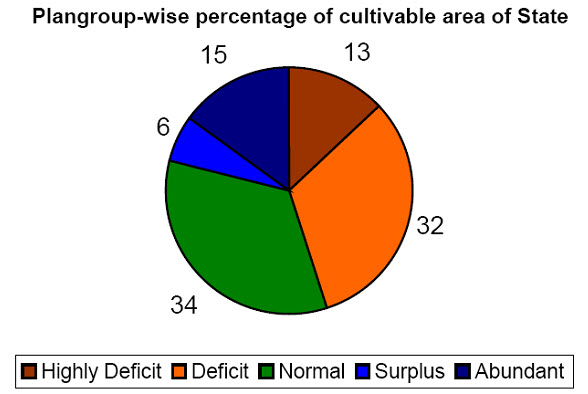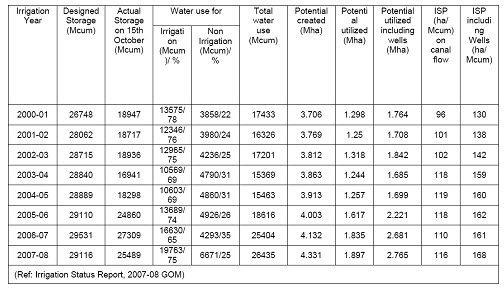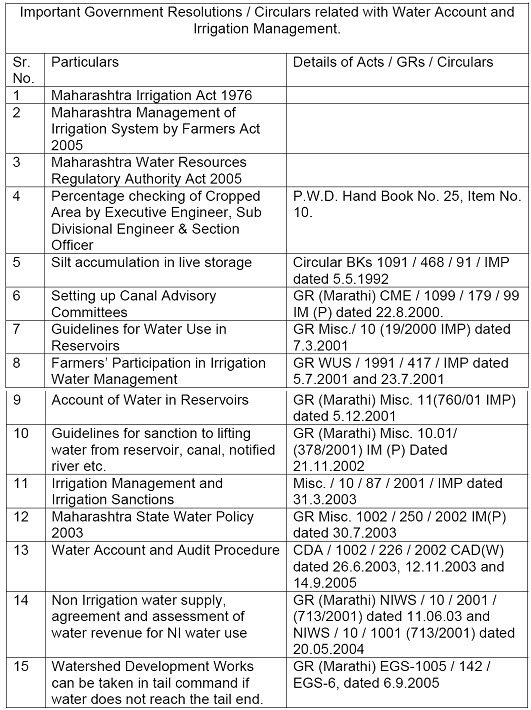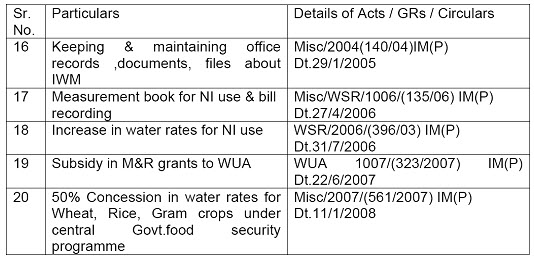Site pages
Current course
Participants
General
Module 1 - Water availability and demand and Natio...
Module 2 - Irrigation projects and schemes of India
Module 3 - Concepts and definitions
Module 4 - Command Area Development and Water Mana...
Module 5 - On-Farm-Development works
Module 6 - Water Productivity
Module 7 - Tank & Tube well irrigation
Module 8 - Remote Sensing and GIS in Water Management
Module 9 - Participatory Irrigation Management
Module 10 - Water Pricing & Auditing
LESSON 32. Water Auditing
Introduction
Water auditing is a systematic & scientific examination of water accounts of the projects. It is an intelligent & critical examination by independent organization. It is a critical review of system of accounting. A water audit determines the amount of water used in different sectors, lost from distribution system due to leakage & the cost of this lost utility. Comprehensive Water Audit can give a detailed profile of distribution system & water users, there by facilitating easier & effective management resources and improved reliability. It may also prove as an effective tool for realistic understanding & assessment of present performance level of the service for future expansion Water auditing process involves checking of sector-wise water use against project planning, Preliminary Irrigation Programme, and assessment of Irrigation System Performance (ISP) and losses actually realized on the projects.
Water audit facilitates comparison between planned Irrigation System Performance (i.e. ha /Mm3) and actual Irrigation System Performance (i.e. ha/ M m3) realized on the project. This will provide information about loss of water in the system. Water audit thus helps in identifying the causes of low ISP & excessive losses in the system. Service Provider then can initiate the action for minimizing the losses and improving the ISP.
32.1 Water Auditing Scenario:
The Central Water Commission, Ministry of Water Resources, GOI & Central Ground Water Board took an initiative in this regard and issued guidelines for water auditing of projects in December 2005. These guidelines are only indicative and on broad spectrum. Every State is required to prepare its own guidelines considering peculiarities and necessities of individual State.
Classification of sub basins for planning, on the basis of naturally available quantum of water, is given below:
|
S. No. |
Plan group |
Per ha availability (m3) |
|
1 |
Highly Deficit |
Below 1500 |
|
2 |
Deficit |
1501-3000 |
|
3 |
Normal |
3001-8000 |
|
4 |
Surplus |
8001-12000 |
|
5 |
Abundant |
Above 12000 |
32.2 Water Auditing-case study of Maharashtra State:
Large number of irrigation projects is constructed in Maharashtra to harness the water resources of the State. Irrigation potential to the tune of 4.331 Mha is created by the end of June 2007 through 66 Major, 233 Medium & 2777 State sector Minor irrigation projects. Maharashtra is the first state in India to incorporate the subject of water audit in State Water Policy as a sector reform in water management and has taken up the issue since 2003-04.
Details of Year wise projects audited are as exhibited below.
|
Year |
No. of Projects |
|
2003-04 |
1229 |
|
2004-05 |
1624 |
|
2005-06 |
1957 |
|
2006-07 |
1971 |
|
2007-08 |
2007 |
With increasing population, urbanization, and industrialization, the water demand is increasing day by day from various sectors. Table 32.1 shows the year wise details of storages available, irrigation & non-irrigation water use & Irrigation system performance achieved at State level.

Table 32.1 Storages available, irrigation & non-irrigation water use & Irrigation system performance.

(Ref: Irrigation Status Report, 2007-08 GOM)
Water auditing of irrigation projects which are constructed through public investment is necessary to see that the water use, evaporation & other losses are as per design. If there is any variation, as mentioned above, water auditing enables to locate the reasons for the same and facilitate suitable corrective measures.
In compliance to commitment in State Water Policy, Government issued a circular dated 26.06.2003 briefing there in methodology to be adopted for keeping project wise water account and its auditing. Administrative arrangements are set up by creating water audit units under Chief Engineer, Maharashtra Water Resources Development Centre, Aurangabad. Accordingly, the MWRDC office is carrying out the water audit of all State sector projects since last five years.
32.3 Water Audit Procedure
32.3.1 Checking Water Account
Government of Maharashtra vide circular dated 26.06.2003 has enforced the field officers to submit the annual water accounts of all State sector irrigation projects under a circle in prescribed proformae by 14th August every year. For effective implementation of the decision based on water audit analysis and timely publication of annual water audit report, a time-bound programme as mentioned below is framed & strictly adhered to.

On receipt of the water accounts, its scrutiny is carried out in MWRDC Office. While scrutinizing the water account of a project, emphasis is given on following points.
i) Total available live storage is tallied with different water uses, evaporation losses, leakages, replenishment received in June and unutilised water at the end of irrigation year.
ii) Season-wise availability and extent of water use.
iii) Irrigation System Performance actual observed as compared to norms fixed by GOM.
iv) Actual evaporation losses as compared to designed evaporation losses.
v) Percentage of leakages through dam and its location, efforts taken by field staff to minimise or stop the leakages.
ix) Actual season wise water use & area irrigated as compared to project planning / Preliminary Irrigation Programme
32.3.2 Inspection of Irrigation offices
To have a cross check over the data submitted in water account & to verify whether record about water storages, water use, different losses along with crop wise area measurements, revenue assessment/ revenue recovery are maintained up-to-date & in prescribed form, annual inspections of Irrigation offices is carried out each year. An annual inspection programme, for inspection of irrigation management divisions, is prepared and communicated to the field officers. According to this programme, inspections are conducted.
During such office inspections, to ascertain the validity of water account data submitted to MWRDC, normally following records are checked.
i) Daily lake level & water storage register.
ii) Daily evaporation record register (Major & Medium projects)
iii) Main Canal gauge register to evaluate water let out in canal for irrigation (daily, rotation-wise, season-wise)
iv) Agency-wise non irrigation water use register.
v) Register for leakages through dam.
vi) Record of measurement of irrigated area
vii) Crop-wise area assessed.
viii) Revenue recovered
Revenue recovery being an important aspect of irrigation management, a review of revenue assessed, recovered, and balance at the end of the year is specially taken during such inspections. Preparation and sanction of Preliminary Irrigation Programme (PIP) before stipulated period, conducting meetings of canal advisory committee, timely and wide publicity to Public Notice, timely submission of rotation-wise water demands and water use by field offices to controlling authorities, daily gauging of discharges through distributaries/minors plays an important role in Irrigation Water Management of a project. Whether such procedure is followed or not is also verified by scrutinizing the relevant records during field office inspections. The lapses, deficiencies noted during the inspection are then communicated to concerned Executive Engineer under intimation to concerned Superintending Engineer, for submitting relevant clarification and taking proper action for improvement in future. In order to streamline the working of water audit units, inspection/ methodology, procedure for compliance of water audit paragraphs etc, Water Audit Manual is under consideration for approval.
32.3.3 Water Audit Report 2007-08
During 2007-08, water accounts of 52 major projects (having 73 reservoirs), 199 medium projects (having 201 reservoirs) & 1756 State sector minor projects were received and audited. The water audit report is limited to these projects only. The decrease in total Nos of major projects is due to grouping of reservoirs in a complex project. At present, there are 63 divisions which are looking after the irrigation management mainly of completed projects in the State. There are many projects under construction where partial irrigation potential is created. On these projects irrigation is managed by construction organization only. The details of the report can be accessed at www.merdc.org/downlods/wa0708.pdf
32.4 Guidelines for efficient and economical use of water
Detailed guidelines are issued from time to time by Government, for efficient and economical use of water available for irrigation. Some extracts from the Government Resolutions dated 14.03.1988, 02.11.1988, 7.3.2001, 05.12.2001; 21.11.2002 and 20.05.2004 are as follows.
i) Irrigating maximum possible lands with available discharges.
ii) Adopting rotational water supply.
iii) Keeping flow period to the minimum possible by letting maximum possible discharge in canal to minimize the transit losses.
iv) Encourage night irrigation.
v) Encourage farmer’s participation in irrigation planning and implementation through canal advisory committees, and village meetings.
vi) Keeping water accounts rotation-wise and season-wise water accounts for watching the efficiency of water use by concerned field staff & officers.
vii) Setting up evaporimeters at every project, having CCA more than 1000 ha, for correct assessment of evaporation.
viii) Providing measuring devices on canals wherever necessary.
ix) The responsibility of giving water account of minor projects rests with the concerned Sub Divisional Engineer and Executive Engineer and with the Executive Engineer & Superintending Engineer in case of major & medium projects.
x) The norms for Irrigation System Performance in Rabi & Hot Weather season are decided as 150 ha/Mcum and 110 ha/Mcum respectively.
xi) Percentage checking of cropped area by Executive Engineer, Sub-Divisional Engineer & Section Officer for assuring 100 percent assessment of irrigated area.
xii) Norms for Quota of water for lift irrigation on reservoir and canals
xiii) Agreement for water supply for Non Irrigation water use (by electronic meter) and assessment of water revenue.
A statement showing list of important Resolutions and circulars, issued by
GOM, from time to time is appended as follows:

